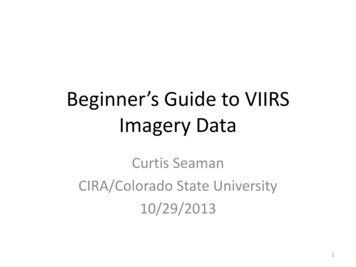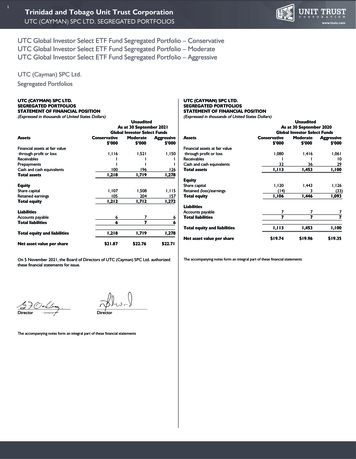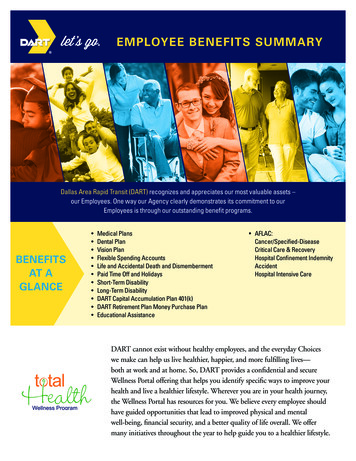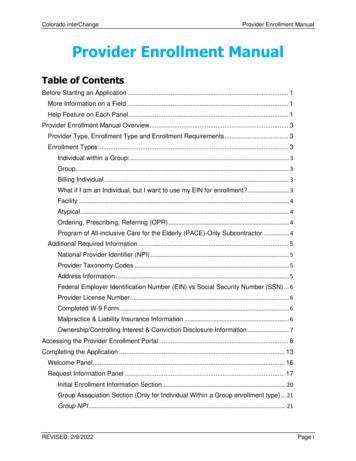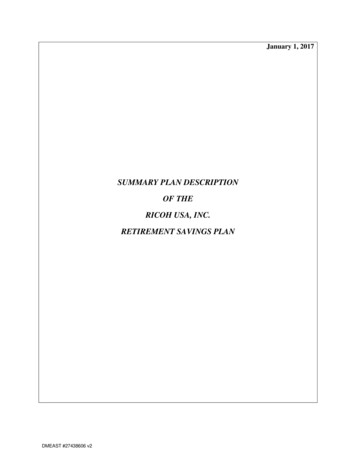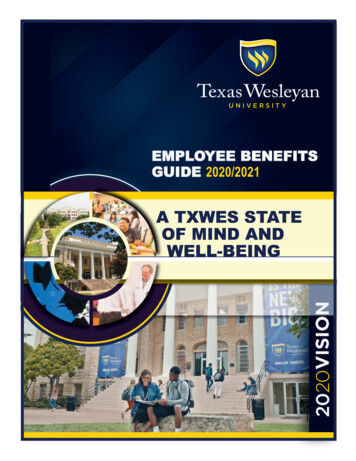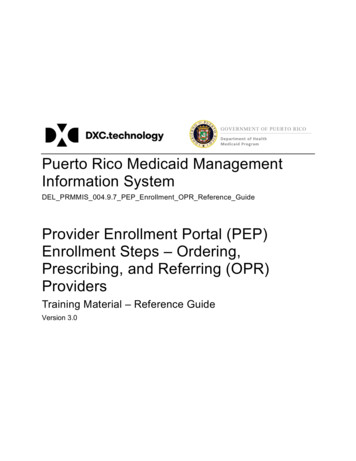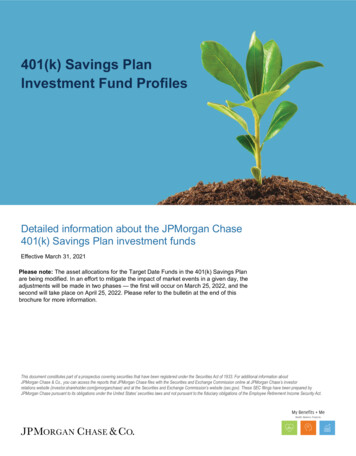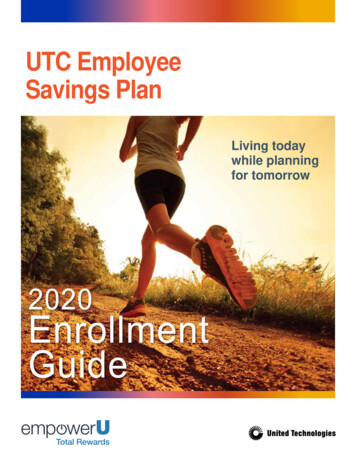
Transcription
UTC EmployeeSavings PlanLiving todaywhile planningfor tomorrow
Why Save Now? . 5Steps to Getting StartedSTEP 1:Decide How Much to Save . 6STEP 2:Choose Your Investments . 8STEP 3:Enroll and Manage Your Account Online . 11VISIT:Your Gateway throughempowerU or via the internet atwww.yourtotalrewards.com/utcCALL:AccessDirect at1-800-243-8135 and followthe prompts for Savings &Retirement. Representativesare available from 8:00 a.m. to8:00 p.m. Eastern Time (ET),Monday through Friday.The UTC Savings Plan (the “Plan”) is intended to be a “Section 404(c) plan” within the meaning of the Employee Retirement Inc ome Security Act of 1974 (“ERISA”),as amended from time to time. As a Section 404(c) plan, the Plan provides participants with sub stantial benefits but also comes with substantial responsibilities. Forexample, the Plan offers participants a broad range of investment options, as well as access to sufficient information and to ols to help you make informedinvestment decisions. The Plan also permits you to move your assets between investment options at virtually any time, subject to reasonable “excessive tra ding”rules. But Plan participation (like participation in any Section 404(c) plan) also comes with important responsibilities. Per haps most importantly, you are solelyresponsible for investment decisions and the results of those investment decisions. This means that neither UTC, the Plan, th e Plan’s Administrator nor anyfiduciary has any legal liability if you suffer any investment losses as a result of your decision to participate in this Plan. In the event of any conflict between theinformation in this document and the Plan document, the Plan document will govern. Please keep in mind that UTC has the right to terminate the Plan or to changeany of its terms, including its benefits formula, at any time.2
You’re noweligible to enroll in theUTC Savings Plan.Your future starts today, and so should your saving for it. To make it easier for you to have a HealthyWallet, UTC provides many tools and resources like the UTC Savings Plan (The “Plan”). Visit the HealthyWallet tile on the Savings & Retirement tab of Your Gateway to take advantage of the tools that will helpyou identify the savings opportunities you may not even know exist, making it easier for you to participatein the Plan.You are automatically enrolled in the UTC Savings Plan (see page 4), but UTC encourages you to activelyenroll and make savings and investment decisions based on your unique retirement goals. By being anactive participant in your savings, you can choose the most appropriate savings opportunities, contributionrate and investment option(s) for your current situation and future savings goals.This guide will explain how you can make the most of the Plan by outlining itskey features and detailing the investment options available to you. Convenient, automatic saving through payroll deductions Tax benefits and the power of compounding, which can helpyour money grow Diverse investment options to suit your needs Tools and resources to help you make informed decisionsYou may also be eligible to receive Company matching and/or automaticcontributions. See the Summary Plan Description for more details.3
Enrollment Is AutomaticWhen you are automatically enrolled in the Plan, 6% of your before-tax eligible earnings will be deductedfrom your pay each pay period and invested in the Lifetime Income Strategy. Also, this contribution rate willautomatically increase by 1% of your eligible pay each year in April until it reaches 10%.You can change these default elections at any time after being automatically enrolled in the Plan. TheLifetime Income Strategy invests in a portfolio that includes a diversified mix of stocks and bondsappropriate for your age. The investment mix is based on your date of birth and, similar to the Plan’scurrent Target Retirement Funds, it assumes a retirement age of 65.Over time, the asset allocation managers automatically adjust your portfolio for you, so your investment mixmakes sense for your age. This means that as you move closer to retirement, the portfolio allocationadjusts to manage your investment risk. The Lifetime Income Strategy has an insurance component thatwill provide a set income amount — or Income Benefit — that will last throughout your retirement.Please note that you can change your contribution percentage, contribution type and investment optionsat any time after being automatically enrolled in the Plan by visiting Your Gateway.4
Why Save Now?Most of us will be responsible for providing the majority of our retirement income. Longer life spans, therising cost of living and increasing health care costs are all compelling reasons to begin saving throughthe Plan.How Compounding Can Help You SaveCompounding means that each dollar you contribute has the potential to generate earnings or grow. Thoseearnings may then generate more earnings and so on. Compounding starts slowly and builds momentumover time.And, since earnings on before-tax and after-tax contributions aren’t taxed until you make a withdrawal, themoney you don’t pay in taxes stays in your account and accelerates compounding. Roth 401(k)contributions go one step further: the money in your account is sheltered from taxes and can be withdrawntax free if certain requirements are met.See page 6 to learn more about contribution types.The following example shows how 5,000, invested annually over different periods of time, will grow as aresult of compounding.COMPOUNDING: EVEN MORE POWERFUL OVER TIME 1,400,000See the difference that starting just 5 years earlier can make 1,200,000EARNINGS 1,000,000CONTRIBUTIONS 800,000 943,161 600,000 616,687 400,000 237,419 200,000 205,000 180,000 130,00025-6530-6540-65 0START AND END AGEThis hypothetical example assumes contributions on January 1 of each year and a 7% annual rate of return compounded monthly. The endingvalues don’t reflect taxes, fees or inflation. Earnings and before-tax (deductible) contributions are subject to taxes when withdrawn. Investingin this manner doesn’t ensure a profit or guarantee against a loss in declining markets. Your own Plan account may earn more or less thanshown in this example.5
Step 1: Decide How Much to SaveBefore you choose how much money to contribute from each paycheck to your Plan account, it’s importantthat you understand the types of contributions you can make. In the tables below, you’ll find the taxadvantages and other characteristics of each contribution type, followed by the Plan/IRS limits for each.CONTRIBUTION TYPEEMPLOYEECONTRIBUTIONSBEFORE-TAXROTH 401(K)*AFTER-TAX*Contributions come out of yourpay before taxes are deducted,which can reduce your taxableincome and, therefore, yourcurrent tax bill.Contributions come out of yourpay after taxes are deducted, soyour taxable income and currenttax will bill not be reduced.Contributions come out of yourpay after taxes are deducted, soyour taxable income and currenttax will bill not be reduced.TAX TREATMENTUPONWITHDRAWALContributions and earnings aretaxed upon withdrawal.Contributions and earningsaren’t taxed upon withdrawal aslong as:1. It has been at least five yearsfrom the date of your firstRoth 401(k) contribution AND2. Earnings are withdrawn afterage 591/2 or are distributedupon your disability or death.Contributions are not taxedupon withdrawal, but earningsare taxable.MAY BE SUITABLEIF YOU.Want to save on taxes today andexpect to be in a lower taxbracket in retirement.Want the maximum amount oftax-free money available inretirement; expect to be in ahigher tax bracket in retirement.Want tax-free money available inretirement; expect to be in ahigher tax bracket in retirement.* Note: If you want to contribute on an after-tax basis, carefully consider the tax benefits available with Roth 401(k) contributions compared totraditional after-tax contributions.2020 ANNUAL CONTRIBUTION LIMITSMaximum compensation limit 285,000Maximum before-tax and/or Roth 401(k) contributions(excluding catch-up contributions) 19,500Maximum contribution limit(including employee contributions, company match/automatic contributions;excluding catch-up contributions)The lesser of: 100% of eligible pay or 57,000Maximum before-tax and/or Roth 401(k) catch-up contributions 6,500Highly compensated employee(a highly compensated employee is an employee who earned 125,000 ormore in 2019, as defined by the IRS)Before-tax: 22%. After-tax: 6%. Roth 401(k): 22%Combined Maximum Contribution: 22%Non-highly compensated employeeRefer to the Summary Plan Description, viewableon Your Gateway.For help choosing the best contribution type for your situation, visit Your Gateway.6
Need Help Deciding How Much to Save?It’s important to save as much as you can through the Plan. However, if you’re like most people, you face anumber of competing financial priorities and may not be able to contribute as much as you’d like rightaway. If that’s the case, take advantage of the many tools available through Healthy Wallet to help you lookfor opportunities to increase contributions over time.One easy way to save more is electing the automatic increase option when you enroll. Your contributions willautomatically increase annually by an amount you select until you reach your goal rate. You can choose themonth and day of your increase. However, if you make an election in the current month, your first annualincrease will occur next year.Still not sure you can afford to save? Even if you think every dollar in your budget is accounted for, youmight be surprised where you can find extra money and how much it can add up to over time, as the tablebelow shows.FIND MONEY TO SAVECOMMON PURCHASESAND THEIR PRICEANNUAL COSTINVESTED FOR 30YEARSMORNINGCOFFEE2 MOVIE TICKETS &POPCORNLUNCH OUTEACH WORKDAY 2.50/DAY 29.50/WEEK 4.50/DAY 913 1,534 1,170 89,479 150,340 114,666This hypothetical example is for illustrative purposes only. Example assumes monthly contributions made at the beginning of each month into aretirement savings plan and a 7% annual rate of return compounded monthly.The Company match can also be a powerful feature in helping you build your retirement savings. To see ifyou’re eligible for this benefit, please refer to the Summary Plan Description, viewable at Your Gateway.If eligible, be sure to contribute enough to receive the full match, which is free money. Please note that ifyou’re eligible to receive Company automatic contributions, you won’t be required to make your owncontributions to the Plan in order to receive them.7
Step 2: Choose Your InvestmentsAs you decide how and where to invest your contributions in the Plan, there are several questions you canask yourself to help make your choices.The first few questions you should ask yourself are:“How do I intend to use my benefits from the Plan? Will I rely on them as a key source ofincome in retirement? Or will I use something else?”Whether you plan to use your money to provide a steady and secure retirement income from the time youretire or you’re looking to take a lump-sum payment to buy a retirement home, you’ll need to be sure yourinvesting approach can support your goal.Next you should ask yourself:“How much time do I have before I need to take my benefits from the Plan?”If you intend to invest your money over a relatively long period, you may be willing to accept a higher levelof uncertainty for some period of time because you’ll have time to make up any investment loss you mayexperience due to a market downturn.On the other hand, if you’ll need to use your money in the near future, you may prefer to choose optionsthat reduce the level of uncertainty with your investment, even if it means giving up potentially higherreturns. And of course, while you can’t control or time the market — and the investment gains and lossesyou’ll likely experience during the time you’re a Plan participant — you can control the amount youcontribute. So, be sure you’re contributing enough.The next question you should consider is this:“Now that I know what I want to do with my benefits and how long I have until I will takemy money from the Plan, am I comfortable directing my contributions?”To help answer this question, you may need to think about what type of investor you are by consideringthese additional questions. There are no right or wrong answers:1. “Do I have the desire to take a ‘hands-on’ approach to investing by customizing my own portfolio andselecting my own mix of investment options?”2. “Am I comfortable deciding how much to invest in each option and making decisions to buy or sell?”3. “Do I have the time and knowledge to sufficiently monitor my own investments and periodically makechanges as I get closer to retirement?”If you answered “no” to any of these questions, you may decide you would be more comfortable letting aprofessional manage your portfolio for you. If you answered mostly “yes,” you may prefer to manage yourPlan account on your own. It’s your choice.8
Depending on your investment know-how and risk tolerance, you can use any one or a combination of thefollowing ways to determine how to invest your savings:Using the Lifetime Income Strategy or Target Retirement FundsThe Lifetime Income Strategy and the Target Retirement Funds offer “built-in” diversification within a singleinvestment option by investing in a portfolio that includes a diversified mix of stocks and bonds appropriatefor a retirement age of 65.Over time, the asset allocation manager automatically adjusts your portfolio for you so your investment mixmakes sense for your age. This means that, as you move closer to retirement, the portfolio allocationadjusts to manage your investment risk. Additionally, the Lifetime Income Strategy incorporates aninsurance component to provide a steady stream of secure retirement income for life. If you choose toinvest in the Target Retirement Fund, you must also pick the one that’s right for you by electing the oneclosest to the year in which you expect to retire (or the year in which you anticipate drawing on yourretirement account).Using eight core options and UTC stockYou can mix and monitor the core funds to achieve diversification among several asset classes. Whencreating your own investment strategy, it’s important to consider a number of factors, including your: Time horizon until retirement. More aggressive investments may be appropriate if retirement is stillfar away and you have time to recover from market losses. More conservative investments may beappropriate if retirement is approaching, since they may lessen the negative impact a market downturncould have on your savings.Tolerance for investment risk. If you can tolerate stock market fluctuations for the chance to earngreater investment returns, more aggressive investments may be appropriate. If your worries aboutlosing money outweigh your desire to pursue potentially higher returns, more conservative investmentsmay be appropriate.Savings goals. If you need to accumulate a sizable retirement nest egg, investing in more aggressiveinvestments that can produce a higher return may be appropriate. If you’re closer to reaching yourretirement goals, more conservative investments that can help reduce risk may be appropriate.Using a mutual fund brokerage window (at an additional cost)The mutual fund brokerage window, which provides access to more than 8,000 funds, is designed for thosewith very specific investment views. It may be attractive to you if you’re an experienced investor looking fora wider range of options from which to choose and you want to research and monitor your investments onyour own. It’s important to know that the brokerage window costs more and often carries additionalinvestment risk. Specifically, you’ll pay a 16 quarterly maintenance fee for access to the program.In addition, many of the mutual funds available are actively managed and carry higher investmentmanagement fees than the Plan’s low-cost, core investment options. Some are also subject to transactionfees. Please carefully consider the additional costs and risks before investing in the brokerage window.9
Stay BalancedOnce you choose the investment strategy that’s best for you, we encourage you to review it regularly,especially anytime your personal situation changes.What is diversification?The Plan offers a broad selection of investment options and asset classes, providing you the opportunityto manage investment volatility and risk by diversifying your investments. Diversification means balancingyour risk by choosing different investment options to help make your savings less vulnerable todeclines in any single asset class or stock. Investment professionals agree that diversification is arisk reduction strategy.Three Approaches at a GlanceCHOICE 1:CHOICE 2:CHOICE 3:Let a Professional Manage It for YouDo It YourselfDo It Yourself With More ChoiceAGE-BASED Lifetime Income StrategySTABLE VALUE Income FundTARGET DATE-BASED Target Retirement Maturity FundBOND Government/Credit Bond Fund EQUITY Equity Fund (S&P 500)Target Retirement 2010 FundTarget Retirement 2015 FundTarget Retirement 2020 FundTarget Retirement 2025 FundTarget Retirement 2030 FundTarget Retirement 2035 FundTarget Retirement 2040 FundTarget Retirement 2045 FundTarget Retirement 2050 FundTarget Retirement 2055 FundTarget Retirement 2060 FundBROKERAGE WINDOW Mutual Fund Brokerage Window Small Company Stock Fund International Equity Fund Emerging Markets Equity FundALTERNATIVE ASSETALLOCATION Multi-Market Risk Parity FundSUPPLEMENTAL STRATEGY Inflation Sensitive Assets FundSINGLE STOCK FUND UTC Common Stock FundTarget Retirement 2065 FundTo obtain Morningstar profiles for each investment option, review fund performance or access investmenteducation and planning tools, visit Your Gateway.To obtain Morningstar profiles for each investment option, review fund performance, or access investment education and planning tools, visit Your Gateway.10
Step 3: Enroll and Manage Your Account OnlineNow that you’ve decided how much to save and determined your investment approach, you’re ready toenroll on Your Gateway.Your Gateway is an integrated, personalized websitedesigned to give you a comprehensive experience —from giving you the ability to more quickly see howyou’re spending your benefit dollars to helping youunderstand the total value of your rewards with UTC.To Get StartedFrom the Your Gateway Home Page below: Enroll in the PlanClick on Start Saving. Elect the Plan default contribution and investment elections via theQuick Enrollment option or choose Advanced Enrollment to enter your contribution andinvestment elections. Elect a beneficiary From the Home Page, select the Savings & Retirement tab. Then click on Beneficiaries from theMy Account Essentials menu. Update existing beneficiary information. Click on your beneficiary’s name and make changes. To update abeneficiary designation percentage, select Choose Beneficiaries. Then, select Primary or Contingent andassign a benefit percentage. Review and select Submit. Add a new beneficiary. Select Add Beneficiary. Then, verify your marital status and add or updateinformation if applicable. Next, choose a beneficiary type and enter beneficiary information. Finally, selectPrimary or Contingent and assign a benefit percentage. Select Continue, then Review and select Submit.Visit Your Gateway through empowerU or via the internet at www.yourtotalrewards.com/utc.You’ll be automatically enrolled in the Plan, unless you enroll on your own or opt out within 45 days ofyour hire date. If you’re automatically enrolled in the Plan, 6% of your before-tax eligible earnings will bededucted from your pay each pay period and invested in the Lifetime Income Strategy. 1 Also, thiscontribution rate will automatically increase by 1% of your eligible pay each year in April until it reaches10%. You can change these default elections at any time after being automatically enrolled in the Plan.1While starting to save for retirement is important for your financial future, during the first 90 days after automatic contri butions are taken from your pay, youcan initiate a withdrawal by calling AccessDirect. The withdrawal will be subject to federal and state income taxes, but not the 10% early withdrawal penaltythat normally applies if you are under age 59 1/2.Morningstar is a registered trademark of Morningstar, Inc.11
212267Printed on Chorus Art Silk which contains 50% recycled, 25% post-consumer wasteUTC046.1219
UTC Savings Plan. Your future starts today, and so should your saving for it. To make it easier for you to have a Healthy Wallet, UTC provides many tools and resources like the UTC Savings Plan (The "Plan"). Visit the Healthy Wallet tile on the Savings & Retirement tab of Your Gateway to take advantage of the tools that will help
